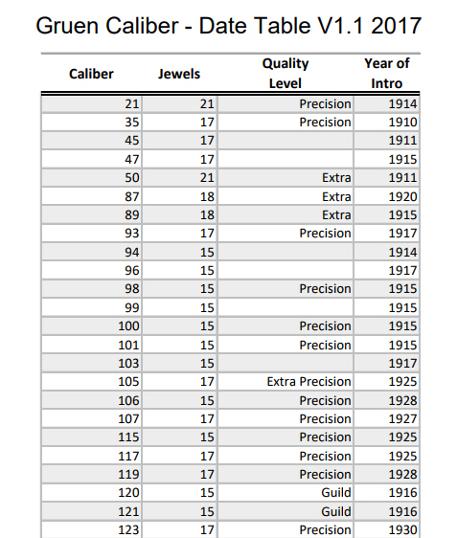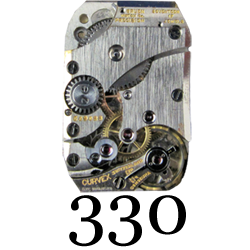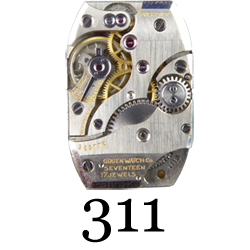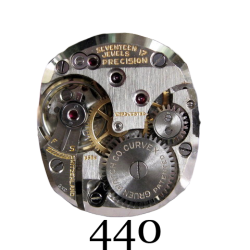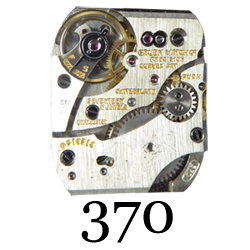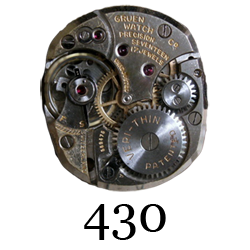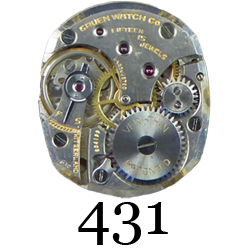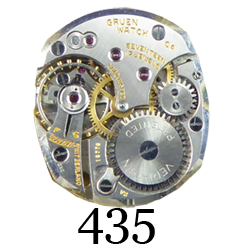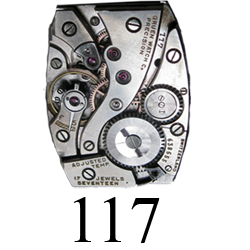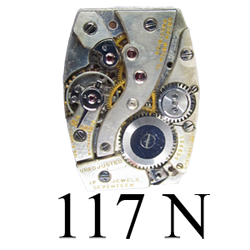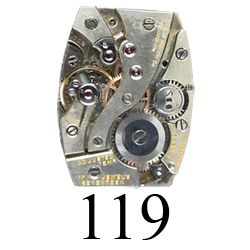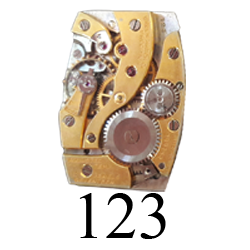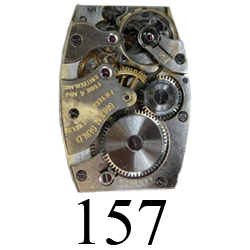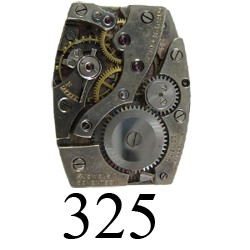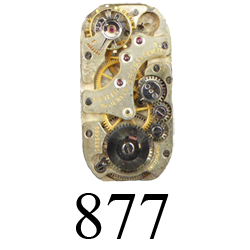Try the Movement Map!
Browse information about Gruen movements like never before using the new Gruen Movement Map. Learn the approx age of your movement by looking up the movement's start of production date. Visually locate your movement on the map.
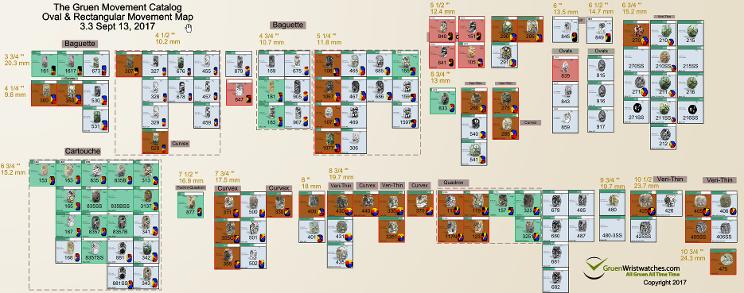
- It is one tool among many. Do not rely on it as your SOLE source of data. Doing so will automatically make you incorrect.
- The researchers that created the table are human and thus error prone
- Gruen made some movements for over a decade. This means YOUR movement could have been made on the date shown or up to 10 years later than that date.
- The movements STOP at the 453 Material Catalog
- The data originates from the list of movements found in the Gruen Material Catalogs. If it's not in a catalog, it is not on this list.
- The movement should be marked with a quality stamp that matches the table.

|
Gruen Movement Catalog - Caliber Date Table V1.1 .pdf Size : 510.739 Kb Type : pdf |
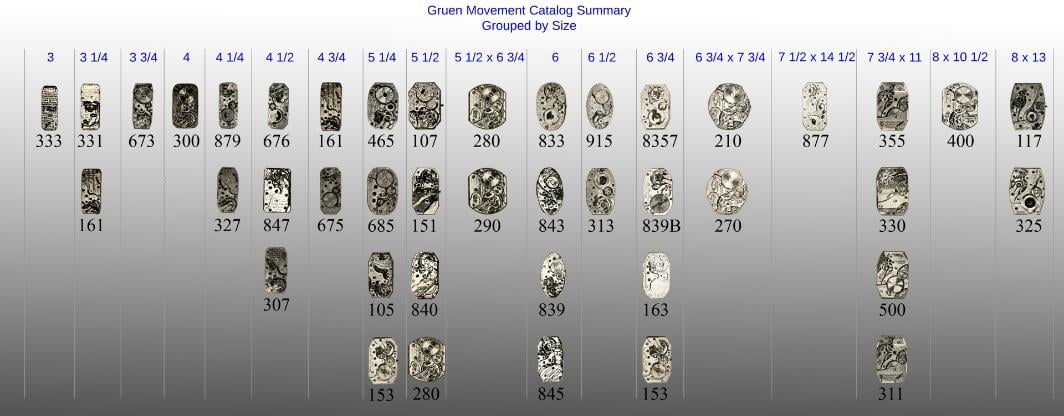
- "Guild" member companies (i.e. ebauche makers)
- Style Number data which informs the usage of these movements over time
- Precision factory information (which factory type and location)
Thank you ebay sellers:
430/440 Family
Must start somewhere, so let's try 430/440 family as these are two of the most common Gruen movements.
The 430 Veri-Thin was launched in 1940 and along with it were the 440 Curvex and the 431, 435 Veri-thins. Together these cover the desired combinations of Precision, Veri-Thin/Curvex, and 15/17 jewels. The 431 is the 15-jewel, non-precision low end movement. The 430 is the 17-jewel Precision Veri-Thin high end movement. The 440 is the high end Curvex movement. In the middle is the 435, a 17-jewel non-precision movement.
Notice how the 430's train bridge has a faux escape-wheel bridge. It looks like the escape-wheel bridge is separate but in fact there is only one single large train-bridge. Presumably this was done to either make the movement look more valuable or to make it easier to identify the escape wheel. While I don't know for sure and haven't researched the history of watch movements that use this, I'm guessing it was for show not as a way for watchmakers to more easily identify the escape wheel jewels as even a watchmaker with only a little training can quickly identify which jewels belong with each wheel. If you know the answer, write me...
Style Numbers.... the secret weapon of Gruen watches...
Style Numbers have turned out to be an incredible resource for researching Gruen watches. It is a unique feature of Gruen watches and thus one that is not used or paid attention to by most collectors or researchers. If you don't know what they are then you should read the article on how to use Style Numbers to date your Gruen watch.
A few words of caution are in order when talking about Style Numbers.... They are not perfect in their ability to date watches nor are they highly reliable at identifying a single watch model as the numbers were re-used. But even with these weaknesses they are very powerful in their abilities to examine overall trends of Gruen watches.
You'll find a Style Number usage graph in each of the Movement Details pages. They graphically show the number of Style Number Pairs found for that caliber of movement. A "Style Number Pair" is a Caliber + Style Number. It is the pair of numbers found in the interior of the back of the cases of most Gruen watches. An example is "440 450". This number you'll find in the back of Curvex Trooper model. It was also used with other models. The point is that one of these pairs may represent multiple models.
One of the outputs of the Style Number research was identifying all of the valid Style Number Pairs. You will find this list in one of the Tables in the Style Number Dating paper. To date there have been 1,238 valid Style Number Pairs. The Gruen Watch Catalog book has 4,368 photos of Gruen watches covering the period of 1923 to 1958. So the number of This number is about 1/4th the estimated number of Gruen watch models from the heart of Gruen's company history. The point is that Style Numbers were re-used and one can't look at these figures in absolute value terms, however, they are useful in making relative comparisons and I think most importantly, understanding how movements were used over time.
Let's look at an example, the very popular caliber 440 movement. You will find this Style Number graph on the 440 movement details page.

This graph is a bar chart representation of this list of Style Number Pairs that are known pairs of Caliber-Style Numbers found in watches. This is the table of raw data graphed:
| Caliber | Style | Style Date |
| 440 | 448 | 1940 |
| 440 | 449 | 1941 |
| 440 | 450 | 1941 |
| 440 | 498 | 1942 |
| 440 | 499 | 1942 |
| 440 | 541 | 1945 |
| 440 | 544 | 1946 |
| 440 | 556 | 1947 |
| 440 | 568 | 1947 |
| 440 | 574 | 1947 |
| 440 | 575 | 1947 |
| 440 | 576 | 1947 |
| 440 | 577 | 1947 |
| 440 | 578 | 1947 |
| 440 | 584 | 1948 |
| 440 | 585 | 1948 |
| 440 | 641 | 1950 |
| 440 | 707 | 1950 |
| 440 | 753 | 1952 |
| 440 | 797 | 1952 |
We know that these Style Numbers were heavily re-used. MANY watches were produced in 1940 that used the caliber 440 movement. The 440 498 pair is known to be used by The Curvex General and Curvex Sentry. Style Number 449 was used in the Curvex Commandant, Knight, Royalty. So we can't look at these number in absolute terms, but we can look at the trend over time and get some sense of how this movement was used. We can see, for example, that it first appeared in 1940 and was used in watches until AT LEAST 1952.
OK, now that caution has been advised when working with Style Numbers, I'm going to throw caution to the wind and stretch things a tad. I've counted the number of unique Style Number Pairs for each movement and graphed it in this bar graph below. What I am attempting to show is the relative popularity of movements. My assumption, which is probably not very sound, is that the Style Number re-use was done across the board, in a relatively uniform manner. Each caliber's count of the number of unique Style Numbers is low by a similar multiplier. Lost yet? It's OK, close your eyes and take a leap of faith and look at the graph as if it's completely valid.
Here is the graph of the top 30 Style Number Pairs. The numbers reflect reality in many ways.
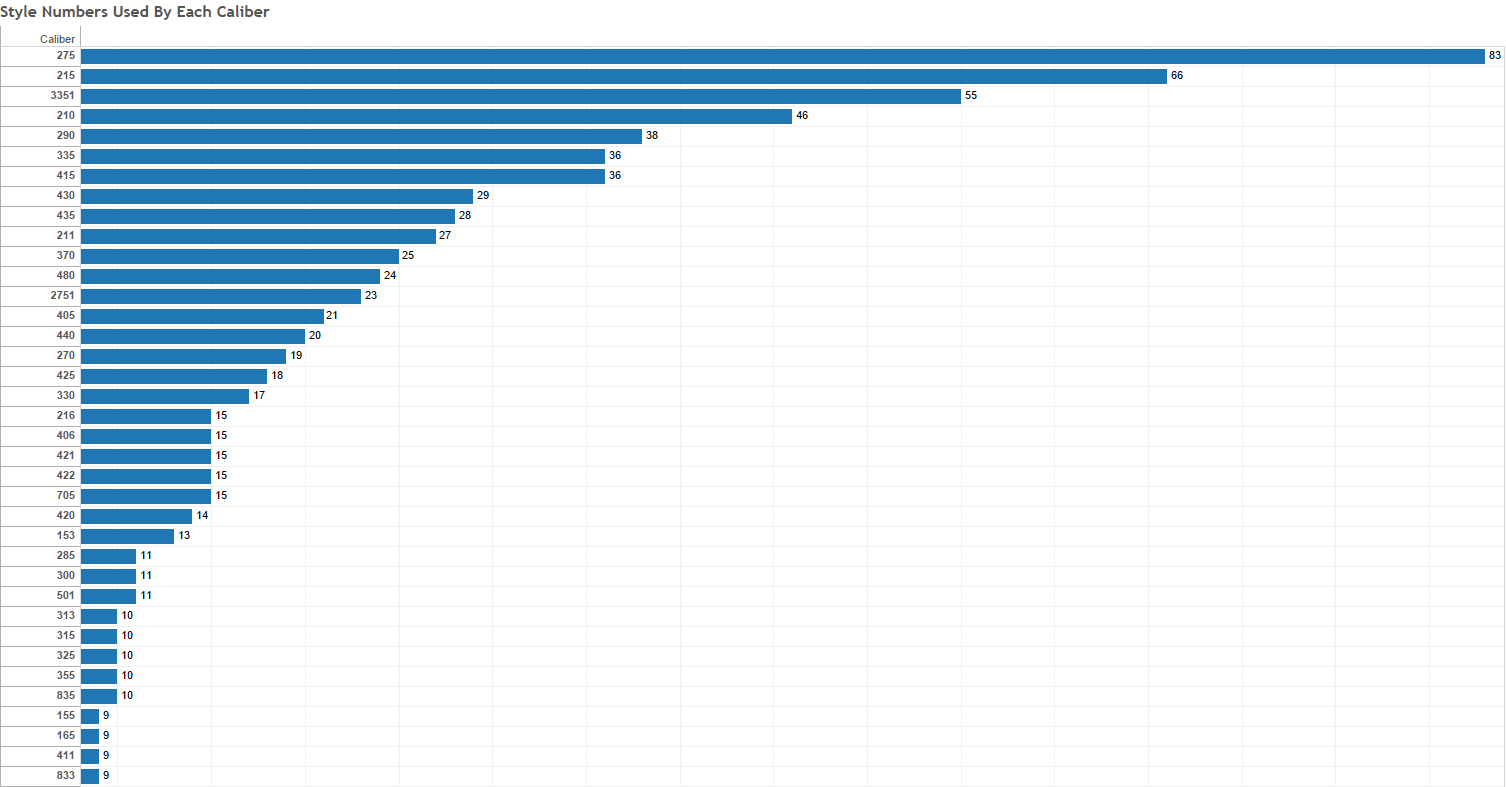
The top movements were:
- 275 - Women's Veri-Thin 5.75 x 7.5
- 215 - Women's 6.75 x 7.75
- 3351 - Men's 8.75 x 9.75 21 jewel
- 210 - Women's Veri-Thin 6.75 x 7.75
- 290 - Women's Veri-Thin 5.76 x 6.75
- 335 - Men's 8.75 x 9.75 17 jewel
The Future
So where is all this headed?
Hopefully a fully populated database of Gruen movement. That alone would be a great accomplishment. However, as the research has crawled forward, we're learning a LOT about other aspects of Gruen's history.
The biggest question I still have and one that I hope will be answered eventually....
What is the numbering scheme for Gruen movements? How were the numbers assigned?
To answer that question, a large table will be populated and examined.
Here's an example of one analysis that led to figuring out what the "N" in the 117N movement means. By populating this table:
| Caliber | Jewels | Precision | Family | Rectangular Mvmt Size Width |
Rectangular Mvmt Size Height |
Round Mvmt Size Diamater |
Year of Intro | Manufacturer | Positional Adjustments |
Temperature Adjusted |
Hairspring | Typical Gender |
| 430 | 17 | Y | Veri-Thin | 8 3/4 | 9 3/4 | 1940 | Gruen | CONORUMA | M | |||
| 431 | 15 | Veri-Thin | 8 3/4 | 9 3/4 | 1940 | Gruen | CONORUMA | M | ||||
| 435 | 17 | Veri-Thin | 8 3/4 | 9 3/4 | 1940 | Gruen | CONORUMA | M | ||||
| 440 | 17 | Y | Curvex | 8 3/4 | 9 3/4 | 1940 | Gruen | CONORUMA | M | |||
| 117 | 17 | Y | Quadron | 8 3/4 | 12 | 1925 | Gruen | Y | M | |||
| 117N | 17 | Y | Quadron | 8 3/4 | 12 | 1925 | Gruen | CONORUMA sometimes | M | |||
| 157 | 15 | Quadron | 8 3/4 | 12 | 1925 | Gruen Guild | 4 or 0 | M |
Other theories about what the N means included "Narrow" because a couple of 117N movement were found in watches with narrower dials than normally found on 117 movements. For a period of time "No difference" was seen between the 117 and 117N movements ;-)
From the data collected in the past few weeks, it's safe to say that 117N movements were ALL not adjusted while 117 movements had Temperature Adjustments. However, it's a stretch to say that the hairsprings differed between 117N & 117 movements across the board because not all of the balance cocks in the 117N movements were stamped with Conoruma hairsprings.
Permission for re-use or distribution, in any format, is neither implied nor granted.
